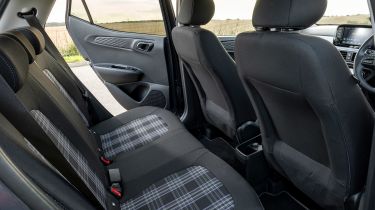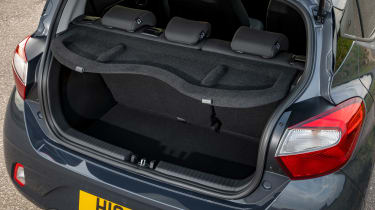Hyundai i10 review - Practicality & boot space
The Hyundai i10 could steal sales from the next class up
The Hyundai i10 has grown quite significantly for the latest generation, with 40mm extra between the front and rear wheels of particular note. This has all been devoted to extra passenger space, placing the i10 between traditional city cars and superminis.
Measuring just 3,670mm in length, the i10 is still a very small car by today’s standards, however, making it ideal for urban driving and parking. Its turning circle of 4.86 metres should also make it easy to U-turn and manoeuvre.
Hyundai i10 interior space & storage
The previous i10 hardly felt small for a car in its class, but the latest model now has rear legroom to compete with cars from the class above. Headroom impresses, even for six-foot adults, and we managed to carry dogs in the i10 without too much bother too.
There are some neat touches too, like the standard rear electric windows that go all the way down for an airy feel – the rear windows in the up! are simple pop-out items. Hyundai is also keen to point out the i10 is a full five-seater, in a class where some key rivals like the up! only have four sets of seatbelts. The mechanically related Kia Picanto only offers five seats on selected trim levels.
Boot space
Boot space has stayed the same at 252 litres, but that's hardly a criticism, as this is still a class-leading size and only around 10% smaller than the Toyota Yaris and Suzuki Swift in the class above. The Toyota Aygo X has a 231-litre boot, and folding the i10’s rear seats down extends luggage space to 1,050 litres, ahead of the Toyota’s 829 litres. Split and folding 60:40 rear seats are standard across the i10 range.
Towing
You wouldn't expect a city car to be able to tow a caravan, but the i10's 300kg maximum towing capacity means it can only handle a very small trailer, perhaps for quick trips to the tip. More realistically, it could also allow a towbar-mounted cycle carrier to be fitted.














